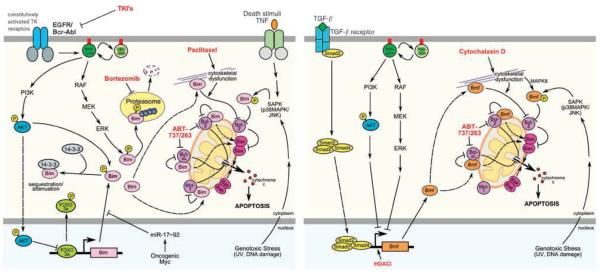Figure 1.
The BH3-only proteins Bim and Bmf are subjected to multiple layers of regulation. Gene transcription of Bim can be induced by inhibition of the AKT survival pathway leading to FOXO3a nuclear translocation and transcriptional activation of bim. Both BH3-only protein genes can be activated by TGF-β-mediated signals, engaging Smad4 and/or RUNX1/3 transcription factors. Translation of Bim can be blocked by binding of c-Myc-induced micro RNAs to the 3′UTR of bim mRNA. At the post-translational level, Bim and Bmf can be rendered inactive by sequestration along microtubules or actin filaments through binding to dynein light chain molecules, DLC1 or DLC2, respectively. Activation of the Ras/Raf/ERK-signaling cascade leads to phosphorylation and to proteasomal degradation of Bim and interferes with induction of Bmf during anoikis by a so far unknown mechanism. Alternatively, phosphorylation of Bim was also reported to prompt cytoplasmic sequestration by 14-3-3 proteins, whereas JNK-mediated phosphorylation of Bim and Bmf is suggested to render the proteins more active. Once activated, Bim and Bmf can neutralize Bcl-2 pro-survival proteins at mitochondria, leading to Bax/Bak activation and Bim may possibly also trigger Bax oligomerization by direct protein–protein interaction. BH, Bcl-2 homology; Bmf, Bcl-2 modifying factor.

